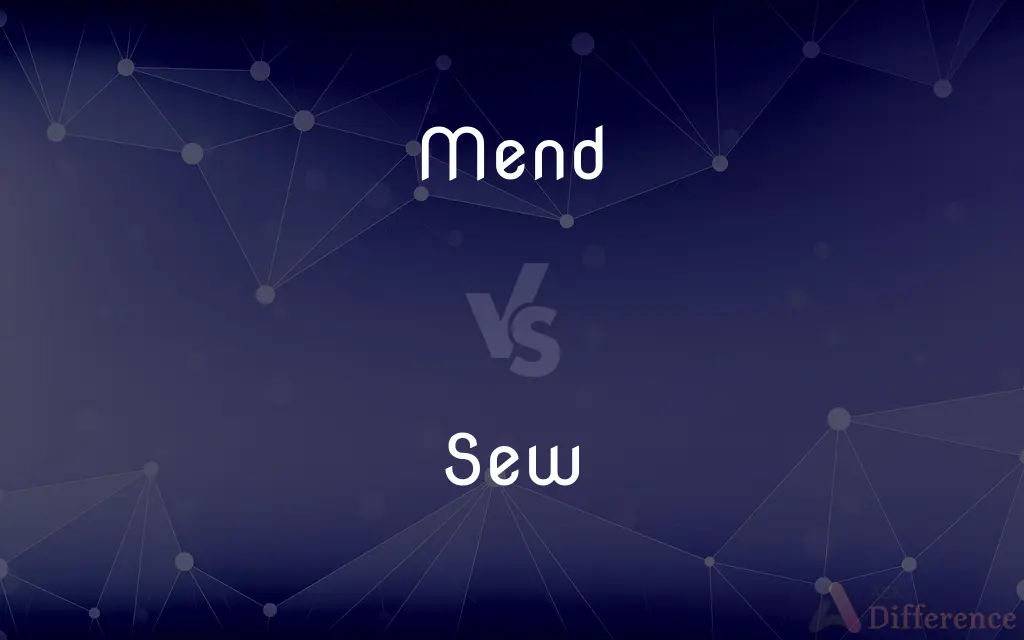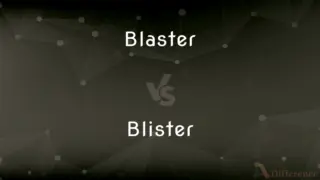Mend vs. Sew — What's the Difference?
Edited by Tayyaba Rehman — By Maham Liaqat — Updated on March 28, 2024
Mending is the broader process of repairing damaged fabric or garments, often involving sewing, while sewing refers to the act of stitching fabric pieces together, for either construction or repair.

Difference Between Mend and Sew
Table of Contents
ADVERTISEMENT
Key Differences
Mending encompasses various techniques aimed at repairing damage to fabric or garments, restoring them to their usable condition. This process can include sewing but also involves patching, darning, and reinforcing areas weakened by wear. Sewing, on the other hand, is specifically the act of joining fabric pieces together with thread and needle, serving as a fundamental technique in both garment construction and repair. While mending focuses on the restoration of fabric integrity and appearance, sewing can be seen as the means to many ends, including the creation of new garments, home décor, and the repair or alteration of existing items.
Sewing is a skill fundamental to mending, as many mending techniques require the ability to sew either by hand or with a sewing machine. However, not all sewing activities constitute mending. For example, sewing can be part of the creative process of designing and making clothing or fabric-based art from scratch, which goes beyond the scope of mending’s primarily restorative purpose. In contrast, mending is driven by the need to extend the life of a garment or textile, reflecting a sustainable approach to fashion and home furnishings.
The tools and materials used in sewing and mending can overlap, including needles, thread, fabric scraps, and sewing machines. However, mending might require additional specialized tools or materials, such as patches, darning wool, or fusible interfacing, to reinforce or repair specific types of damage. This distinction highlights how mending, as a subset of sewing, often demands a more diverse toolkit and a problem-solving mindset to address various forms of wear or damage.
Practically, sewing skills enable individuals to mend their clothes, contributing to a sustainable lifestyle by reducing waste and the need for new purchases. However, the act of sewing can also fulfill creative and aesthetic desires, underscoring the versatility and breadth of sewing beyond its utilitarian role in mending. As such, sewing encompasses a wider range of techniques and applications, from artistic expression to practical garment repair, of which mending is an important, though distinct, component.
Lastly, while the motivation behind mending is often practicality and necessity, driven by the desire to repair and prolong the life of textiles, sewing can be motivated by a range of factors including creativity, custom fit, personal style, and the satisfaction of creating something by hand. This difference in motivation underscores the diverse roles that sewing plays in people’s lives, as opposed to the more focused and utilitarian nature of mending.
ADVERTISEMENT
Comparison Chart
Definition
Repairing fabric or garments, restoring usability.
Joining fabric pieces with thread and needle.
Purpose
To extend the life of textiles and garments.
To construct or repair textiles and garments.
Techniques
Patching, darning, reinforcing.
Stitching, hemming, embroidering.
Tools/Materials
Needles, thread, patches, darning wool.
Needles, thread, fabric, sewing machine.
Motivation
Necessity, sustainability.
Creativity, necessity, personalization.
Compare with Definitions
Mend
Repairing worn or damaged fabric.
She mended the hole in her sweater with darning.
Sew
Can be done by hand or machine.
He prefers to sew patches on his backpack by hand.
Mend
Involves techniques like patching and darning.
Patching is a common mending technique for large tears.
Sew
Joining fabric pieces with stitches.
She sewed a new dress for the party.
Mend
Restoring garments to a usable condition.
Mending his jeans extended their life by a year.
Sew
Facilitates personalization and fit adjustments.
Sewing her own clothes allows her to tailor everything perfectly.
Mend
Aims at sustainability and waste reduction.
Mending clothes is part of her commitment to sustainability.
Sew
Fundamental for both garment construction and repair.
Learning to sew enables both creative design and practical repairs.
Mend
Often requires specific materials for repair.
She used a patch to mend the tear on her canvas bag.
Sew
Incorporates techniques like hemming and embroidering.
She sewed a decorative hem on her skirt.
Mend
To make repairs or restoration to; fix.
Sew
Join, fasten, or repair (something) by making stitches with a needle and thread or a sewing machine
She sewed the seams and hemmed the border
I don't even sew very well
Mend
To reform or correct
Mend one's ways.
Sew
To make, repair, or fasten by stitching, as with a needle and thread or a sewing machine
Sew a dress.
Sew on a button.
Mend
To improve in health or condition
The patient is mending well.
Sew
To furnish with stitches for the purpose of closing, fastening, or attaching
Sew an incision closed.
Mend
To heal
The bone mended in a month.
Sew
To work with a needle and thread or with a sewing machine.
Mend
To make repairs or corrections.
Sew
(transitive) To use a needle to pass thread repeatedly through (pieces of fabric) in order to join them together.
Balls were first made of grass or leaves held together by strings, and later of pieces of animal skin sewn together and stuffed with feathers or hay.
Mend
The act of mending
Did a neat mend on the sock.
Sew
(intransitive) To use a needle to pass thread repeatedly through pieces of fabric in order to join them together.
Mend
A mended place
You can't tell where the mend is.
Sew
(transitive) Followed by into: to enclose by sewing.
To sew money into a bag
Mend
A place, as in clothing, which has been repaired by mending.
Sew
To drain the water from.
Mend
The act of repairing or recovering.
My trousers have a big rip in them and need a mend.
Sew
(nautical) Of a ship, to be grounded.
Mend
(transitive) To repair (something that is torn, broken, defaced, decayed, or otherwise damaged)
My trousers have a big rip in them and need mending.
When your car breaks down, you can take it to the garage to have it mended.
Sew
(obsolete) Broth, gravy.
Mend
(transitive) To put in a better state; to set right; to reform;
Her stutter was mended by a speech therapist.
My broken heart was mended.
Sew
Juice; gravy; a seasoned dish; a delicacy.
I will not tell of their strange sewes.
Mend
To quicken
Sew
To follow; to pursue; to sue.
Mend
(transitive) To help, to advance, to further; to add to.
Sew
To unite or fasten together by stitches, as with a needle and thread.
No man also seweth a piece of new cloth on an old garment.
Mend
(intransitive) To grow better; to advance to a better state; to become improved.
Sew
To close or stop by ssewing; - often with up; as, to sew up a rip.
Mend
To repair, as anything that is torn, broken, defaced, decayed, or the like; to restore from partial decay, injury, or defacement; to patch up; to put in shape or order again; to re-create; as, to mend a garment or a machine.
Sew
To inclose by sewing; - sometimes with up; as, to sew money in a bag.
Mend
To alter for the better; to set right; to reform; hence, to quicken; as, to mend one's manners or pace.
The best service they could do the state was to mend the lives of the persons who composed it.
Sew
To practice sewing; to work with needle and thread.
Mend
To help, to advance, to further; to add to.
Though in some lands the grass is but short, yet it mends garden herbs and fruit.
You mend the jewel by the wearing it.
Sew
To drain, as a pond, for taking the fish.
Mend
To grow better; to advance to a better state; to become improved; to recover; to heal.
Sew
Fasten by sewing; do needlework
Mend
Sewing or darning that repairs a worn or torn hole (especially in a garment);
Her stockings had several mends
Sew
Create (clothes) with cloth;
Can the seamstress sew me a suit by next week?
Mend
The act of putting something in working order again
Mend
Restore by replacing a part or putting together what is torn or broken;
She repaired her TV set
Repair my shoes please
Mend
Heal or recover;
My broken leg is mending
Common Curiosities
What is sewing?
Sewing is the act of joining fabric pieces together with thread and needle, which can be for constructing new items or repairing existing ones.
Can you mend without sewing?
While many mending techniques involve sewing, some forms of repair, such as using adhesive patches or fusible interfacing, may not require sewing.
What’s the difference between patching and darning?
Patching involves covering a hole or tear with a piece of fabric, while darning weaves thread over a tear to reconstruct the fabric.
Is sewing only for making clothes?
Sewing is used not just for making clothes but also for creating home décor, accessories, and for performing repairs or alterations.
How do mending and sewing contribute to sustainability?
Mending extends the life of garments and reduces waste, while sewing can reduce dependence on mass-produced items, both contributing to sustainability.
Why learn to sew if I only want to mend my clothes?
Learning to sew provides the skills necessary for effective mending, and offers the flexibility to undertake a wide range of fabric and garment repairs.
How does sewing contribute to personal style?
Sewing allows individuals to create custom garments and accessories, reflecting their personal style more accurately than off-the-rack items.
What is mending?
Mending is the process of repairing fabric or garments to restore their usability, often through techniques like patching or darning.
Is mending cost-effective?
Mending can be highly cost-effective, as it often requires only basic materials and tools to prolong the life of garments and textiles.
What makes a good mending repair?
A good repair is durable, functionally restores the garment, and is visually pleasing or intentionally discreet, depending on the goal.
Can I learn to sew online?
Yes, there are numerous online resources, tutorials, and classes available that can teach you to sew, from beginner to advanced levels.
Can sewing be a career?
Yes, sewing skills can lead to careers in fashion design, tailoring, costume design, and textile art, among others.
What are some essential sewing tools for beginners?
Essential tools include needles, thread, fabric scissors, a seam ripper, pins, and a measuring tape.
What is the best way to learn mending techniques?
Practicing various techniques on old or damaged garments, guided by tutorials or workshops, is an effective way to learn mending.
How do I choose fabric for my sewing projects?
The choice of fabric depends on the project. Consider the fabric's weight, stretch, and washability in relation to the intended use of the finished item.
Share Your Discovery

Previous Comparison
Extract vs. Juice
Next Comparison
Blaster vs. BlisterAuthor Spotlight
Written by
Maham LiaqatEdited by
Tayyaba RehmanTayyaba Rehman is a distinguished writer, currently serving as a primary contributor to askdifference.com. As a researcher in semantics and etymology, Tayyaba's passion for the complexity of languages and their distinctions has found a perfect home on the platform. Tayyaba delves into the intricacies of language, distinguishing between commonly confused words and phrases, thereby providing clarity for readers worldwide.













































